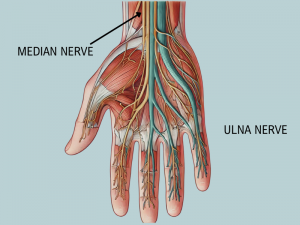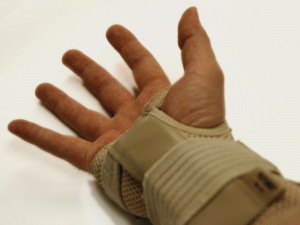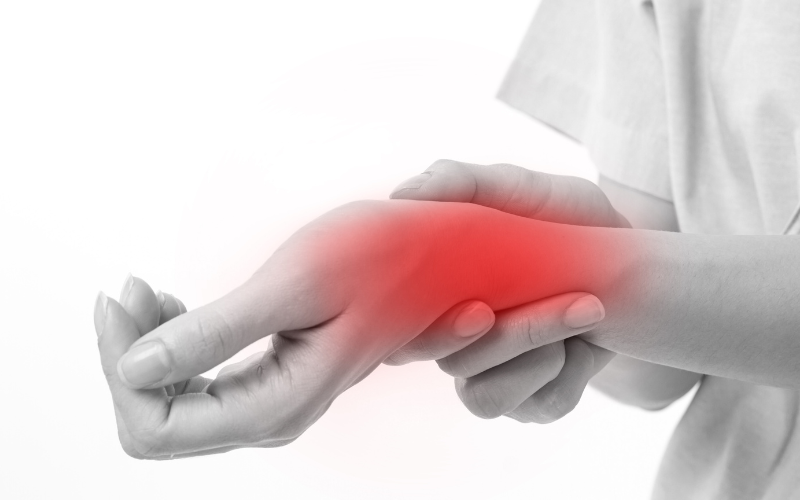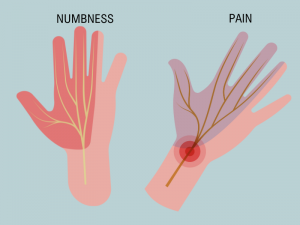Carpal Tunnel Syndrome (CTS) is a painful condition caused by compression of the median nerve as it passes through a narrow tunnel in the wrist. It’s often linked to repetitive movements, such as typing, using tools, or even hormonal changes.
What Does the Median Nerve Do?
The median nerve controls movement and sensation in the thumb, index, middle, and part of the ring finger. When it gets compressed, it can lead to pain, tingling, weakness, and numbness.

Symptoms of CTS
- Tingling, numbness, or pain—usually in the thumb, index, middle, and part of the ring finger, typically triggered by repetitive movements—typing, texting, or using a mouse can make it worse.
- Weaker grip—difficulty holding a pen, using buttons, or gripping objects.
- Worse at night or in the morning—many people wake up needing to shake their hands to relieve symptoms.
- Swelling or inflammation—sometimes linked to arthritis.
If CTS gets worse, you might notice:
- Muscle wasting at the base of the thumb.
- Ongoing numbness or altered sensation in the affected fingers.
What Causes CTS?
There’s no single cause, but contributing factors may include:
- Hormonal changes, such as pregnancy.
- An underactive thyroid (hypothyroidism).
- Diabetes.
- Previous wrist injuries—fractures, sprains, etc.
- Arthritis—especially if it causes swelling in the wrist.
How is CTS Diagnosed?
- A healthcare professional will usually assess CTS with:
- Questions about your symptoms—when they started, what makes them better or worse.
- A physical examination—checking grip strength, sensation, and wrist movement.Simple nerve tests, such as:
-
- Tinel’s Test – tapping over the median nerve at the wrist to check for tingling.
- Phalen’s Test – bending the wrist downward (palm to forearm) for up to a minute to see if symptoms appear.
Treatment
Conservative Treatments
In many cases, CTS improves without surgery. Non-invasive options include:
Wrist Splints
- Resting splints – recommended for night-time use if symptoms worsen overnight.
- Working splints – help keep the wrist in a neutral position during activity, reducing pressure on the nerve.

Physical Therapy (Osteopathy/Physiotherapy)
An osteopath or physiotherapist may suggest specific exercises and splints to prevent the median nerve from becoming restricted by nearby tendons.
Medication
- Steroid injections may provide short-term relief and support rehabilitation through physical therapy.
Surgical Treatment
If symptoms persist despite conservative treatments, or if nerve compression is severe, surgery may be required. Carpal Tunnel Release is a straightforward procedure, typically performed under local anaesthetic as a day-case operation. It aims to relieve pressure on the median nerve, often resulting in symptom improvement. While surgery is generally effective, there is a small risk of complications.
Recovery After Surgery?
- Most people resume light activities within a few days, but full recovery can take several weeks to months.
- Some stiffness, swelling, or tenderness is expected initially.
- Physiotherapy or hand exercises may be recommended to restore strength and flexibility.
- Heavy lifting and forceful gripping should be avoided during the early healing period.
- While most patients experience relief, some may have lingering numbness or weakness, especially if nerve damage was severe before surgery.
What Happens if CTS is Ignored?
If untreated, CTS can progressively worsen, leading to:
- Chronic pain and persistent numbness.
- Weakness in the hand and fingers, making daily tasks more difficult.
- Muscle wastage (atrophy) at the base of the thumb, potentially causing permanent loss of function.
Can You Prevent CTS?
Yes, adopting a few simple habits can reduce your risk:
- Take regular breaks from repetitive movements, especially if using a keyboard, tools, or machinery.
- Maintain good wrist posture by keeping wrists neutral when working with your hands.
- Strengthening and stretching exercises can help maintain flexibility and reduce tension.
- Use ergonomic tools, such as supportive keyboards, padded mousepads, and wrist-friendly equipment.
- Maintain a healthy lifestyle – managing conditions like diabetes and hypothyroidism may help reduce CTS risk.
Final Thoughts
Carpal Tunnel Syndrome is a common but manageable condition. The key is early intervention—whether that’s with simple lifestyle changes, wrist splints or seeking medical advice early to prevent lasting nerve damage
This information is for guidance only and should not replace professional medical advice, diagnosis, or treatment from a qualified healthcare provider.









